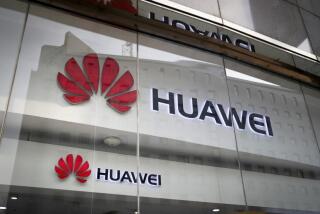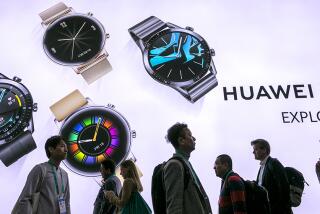U.S., Japan Clear Hurdle on Reaching Chip Pact : Technology: The Japanese drop opposition to an American demand for help in gaining a 20% share of the market.
- Share via
TOKYO — Japanese and U.S. negotiators have overcome a major obstacle to reaching a new agreement that would help American semiconductor makers increase their share of the Japanese market.
In talks that began Tuesday, Japan dropped its opposition to U.S. demands that the agreement include a reference calling for Japan to help U.S. chip makers achieve a 20% share of a market that has become the world’s largest, thanks to Japan’s dominance in electronics.
But any new agreement will be conditional on U.S. removal of punitive tariffs placed five years ago on such selected Japanese electronics products as laptop computers, according to an official of Japan’s Ministry of International Trade and Industry.
The agreement would replace a semiconductor agreement put in place in 1986 that expires in July. Japanese industry opposition to an extension of the 20% market share target, included in a side letter to the current agreement, was regarded as the primary obstacle to reaching a new accord.
Japanese firms had previously expressed concern that the “managed trade” implied in the quantitative target could set a precedent for future agreements. Now they say they recognize that they have little choice.
“If the other side says we aren’t going to play the game unless you make new rules, what can we say?” asked an official at a large Japanese chip maker. “If to protect free trade we need (to be handicapped), then we have to accept it.”
The expiring accord is one of the few trade agreements widely viewed as a success in the United States because it helped boost the American chip-market share in Japan to 13.2% at the end of last year from 8.5% in 1986.
Negotiators are still hammering out a few key points on the new agreement, including the question of how firm the 20% figure is. Japanese officials would like to see it as a target to shoot for. U.S. officials want the Japanese to make a firm commitment to reaching the 20% level within the next year or two.
For U.S. chip makers to win that share, Japanese companies would be forced to move beyond purchases of commodity semiconductors and agree to design U.S. chips into their products, says Roger Mathus, head of the Semiconductor Industry Assn.’s Tokyo office. Such “design-ins” would make it difficult for Japanese firms to drop U.S. suppliers at their convenience, he said.
Mathus said U.S. semiconductor companies have had extensive talks with Japanese auto, communications and consumer products manufacturers and have high hopes of seeing their chips designed into future Japanese products.
Japanese government officials have overcome private-sector opposition to the quantitative targets because of broader concern over worsening relations with the United States. Ties have deteriorated as a result of a perceived weakness in Japan’s support of the U.S. position in the Gulf War and in recent negotiations to expand the role of the General Agreement on Tariffs and Trade.
Also likely to be included in the agreement is a provision requiring Japanese companies to maintain cost data so that if there are charges of dumping against Japanese companies, the U.S. government can move quickly to investigate. Dumping is selling products below cost to gain market share.
In a separate move also seen as an effort to improve relations with American chip makers, NEC Corp. announced Monday a broad-ranging agreement with American Telephone & Telegraph Co. to share process technology critical to manufacturing the next generation of semiconductors.






